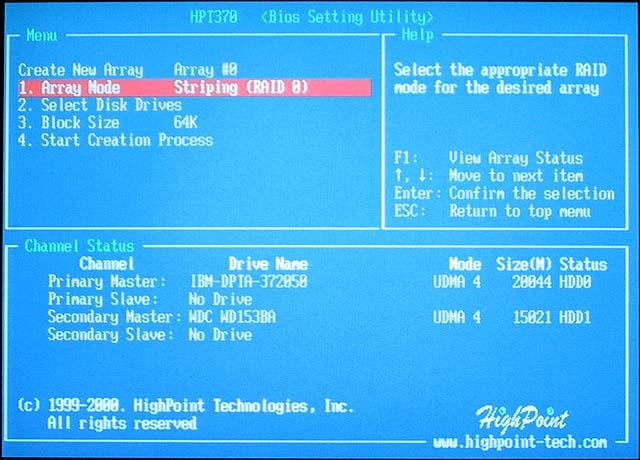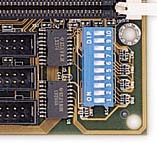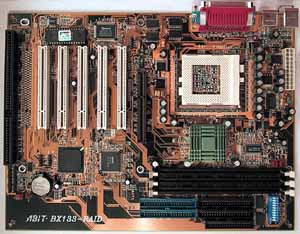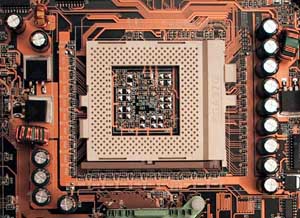
Original Link: https://www.anandtech.com/show/593
ABIT BX133-RAID i440BX Socket-370 ATX
by Mike Andrawes on July 28, 2000 12:00 PM EST- Posted in
- Motherboards
It's been over two years since we first looked at an i440BX board from ABIT, the BX6 that will remain a fond memory to overclockers that owned it for a long time to come. There are still quite a few BX6's that are still chugging along today just fine, likely one of the few components that hasn't been upgraded by those living on the cutting edge of computer hardware technology. First delay's in Intel's i820 chipset, then the absurdly high price of RDRAM combined with its minimal performance improvement, if any at all, have allowed the i440BX chipset to live on much longer than originally planned. In an effort to bring the aging i440BX up to snuff with the latest chipsets from Intel and VIA in terms of specifications, motherboard manufacturers have added everything from on-board Ultra ATA/66 controllers to additional USB ports. Most importantly, they've been able to tweak their i440BX designs so that the 133 MHz FSB is stable as long as the graphics card can handle the overclocked AGP bus.
ABIT has faithfully stuck with the i440BX all along and is now on their ninth board based on the chipset. ABIT was one of the first manufacturers to enhance the i440BX by including a HighPoint Ultra ATA/66 controller on the BE6. The BP6 brought us the first dual processor Socket-370, introducing countless numbers of users to SMP and Windows NT. With the BE6-2 and BF6, they introduced SoftMenu III, allowing for FSB overclocking up to 200 MHz in 1 MHz increments. With BX boards decked out with just about every add-on you can think of and the recent release of the i815, we wondered if we had finally seen the last new BX board.
Apparently ABIT thinks the good ol' BX still has some life left in it and they've brought us the all new BX133-RAID. What more could you possibly add to a BX board? There's no way we're going to get a 1:2 AGP:FSB ratio to make the 133 MHz FSB run completely within spec because that's a function of the chipset. The same goes for AGP 4X support and Intel Hub Architecture (IHA, formerly Accelerated Hub Architecture or AHA).
So what exactly did they do then? Read on to find out...
|
Motherboard Specifications |
|
| CPU Interface |
Socket-370
|
| Chipset |
i440BX
HighPoint HPT370 Ultra ATA/100 RAID |
| Form Factor |
ATX
|
| Bus Speeds |
66
/ 75 / 83 - 200 in 1MHz steps
|
| Voltages Supported |
Auto
Detect
Adjustable to 1.3V - 3.5V |
| Memory Slots |
3 168-pin DIMM Slots
|
| Expansion Slots |
1 AGP Slot
5 PCI Slots (5 Full Length) 0 AMR/CNR Slots 1 ISA Slot |
| Onboard Sound |
N/A
|
| BIOS |
Award Modular BIOS 6.00PG
ABIT SoftMenu III |
The Good
While the BE6-2 and BF6 were evolutionary designs, based closely off their predecessor, the BX6, BH6, BX6 Revision 2.0, the BX133-RAID is definitely a bit of a departure for ABIT. Thanks to Intel's push towards the more cost conscious socketed CPU interface, ABIT's biggest departure from their old design is the inclusion of the Socket-370 in place of the Slot-1 interface all those previous ABIT BX boards have had. ABIT has actually done 2 previous BX Socket-370 boards, the BM6 and the BP6, but both of those boards are considerably different.
Nevertheless, there are still some similarities between the BX133-RAID and ABIT's previous BX boards. The relative positioning of the i443BX North Bridge, memory slots, and clock generator is borrowed for the BE6-2/BF6 as is the layout of the expansion slots, south bridge, and HighPoint controller. The North Bridge, memory slots, and clock generator are all moved forward about an inch to make room for the Socket-370 interface.
The other big change for ABIT is the substitution of the HPT370 controller in place of HighPoint's older HPT366 on older ABIT products. The HPT370 adds Ultra ATA/100 and, more importantly, RAID support in the same compact single chip package. Hard drive performance is by far one of the biggest bottle necks in today's systems, especially for typical everyday use such as most internet and business applications. The HPT370 supports striping (RAID 0), mirroring (RAID 1), and mirroring + striping (RAID 0+1). By buying a motherboard with an integrated RAID controller, you save quite a bit over buying a motherboard and than a separate RAID controller. ABIT has included Windows 98, 2000, and NT 4.0 drivers on their CD, while the HighPoint driver built into the latest Linux kernels should work as well.

The HPT366 has been known to have compatibility problems with certain devices, including CD-ROM's and even some hard drives. It's not yet clear whether all of these issues have been resolved with the HPT370, but your best bet is to search around the net to see if anyone has had any troubles with their BX133-RAID's and the particular devices you plan on having on the HPT370 channels. One benefit of having this controller onboard is that you still have the two Ultra ATA/33 channels courtesy of Intel's PIIX4e South Bridge, which can be used for all non-Ultra ATA 66/100 devices.
In the quest for the ultimate i440BX board, ABIT's also outfitted the BX133-RAID with a 5/1/1/0 (PCI/ISA/AGP/AMR) expansion slot configuration. There are no AMR or CNR slots, nor will there be ever since the i440BX chipset does not support them. The solder pads for a 6th PCI are clearly visible on the board, but just like the BE6-2, this connector is left out because we'd have entirely too many PCI devices without a PCI bridge. As it stands, Intel's PIIX4e South Bridge only supports 5 PCI master devices, and one of those is used up by the onboard HighPoint controller. That means that the 5th PCI slot is actually a slave slot, meaning that no bus mastering devices will function in that slot, but something like a Voodoo2 will work fine. Unfortunately, few current PCI devices can operate in slave mode.
While Tyan and a few others have used a PCI-PCI bridge chip to work around this issue on their 6 PCI motherboards, we think that MSI has a much more elegant and cost effective solution - a PCI arbiter chip. Read our review of the MSI BXMaster for more information on their PCI arbiter chip. The AGP slot shares an IRQ with either the first or the second PCI slot, the fourth and fifth slots still share an IRQ with the USB controller, and the third slot shares an IRQ with the onboard HPT370 controller.
Support for up to 768MB of RAM is provided by 3 DIMM slots. Unfortunately, we did encounter a bit of a problem when running more than 1 DIMM at 133 MHz - regardless of the memory type in use, the system was not stable with more than 1 DIMM at a CAS latency of 2. Turning down the timing to CAS 3 brought stability back to normal, but at a small performance penalty.
As the name suggests, the BX133-RAID is designed with 133 MHz operation in mind and is semiofficially supported this time around. Obviously Intel doesn't condone operation of the i440BX at 133 MHz and ABIT still has the disclaimer in the manual that bus speeds other than 66 or 100 MHz are not guaranteed. Nevertheless, ABIT's success comes from catering to overclockers and that's what they've done here again with the BX133-RAID. That means we get SoftMenu III again, providing for a total of 120 FSB speed settings, more specifically standard 66 / 75 / 83 settings plus speeds from 84 - 200 in 1MHz increments. There is still support for adjusting the PCI ratio (1/2, 1/3, or 1/4 of the FSB speed), AGP ratio (2/3 or 1/1 of the FSB speed), and CPU core voltage (default +/- 0.3V). SoftMenu III also offers the ability to adjust the I/O voltage of the PCI / AGP bus and SDRAM to 3.2 - 3.9V in 0.1 V steps (default is 3.3V), as well as some options for L2 cache latency, all in an effort maximize overclocking potential. The defaults for all these settings are clearly labeled, so causing serious damage will take a bit of work.
 Like
the BF6 and BE6-2, the BX133-RAID features a set of 10 dip switches that can
override the otherwise jumperless SoftMenu III features onboard This is mainly
for OEMs and system integrators concerned with their customers playing around
in the BIOS and potentially causing support headache. As such, it really doesn't
apply to most hardware enthusiasts.
Like
the BF6 and BE6-2, the BX133-RAID features a set of 10 dip switches that can
override the otherwise jumperless SoftMenu III features onboard This is mainly
for OEMs and system integrators concerned with their customers playing around
in the BIOS and potentially causing support headache. As such, it really doesn't
apply to most hardware enthusiasts.
To help ensure that things stay nice and stable during all this overclocking, ABIT has included eleven 1500uF and ten 1000uF capacitors around the Socket-370 interface to provide sufficient power to the CPU under all conditions. ABIT's left plenty of room around the CPU socket such that FC-PGA-C heatsinks can be mounted to the CPU. An FC-PGA-C heatsink is just an oversized heatsink designed for CPU's running at 1 GHz and above. We also see the return of ABIT's oversized green heatsink, last seen on the BP6 and the original BE6, atop the i443BX North Bridge. This careful selection of components, combined with the tried and true layout from previous ABIT BX boards allowed the BX133-RAID to run rock solid during our stress tests. With the KA7 and now the BX133-RAID, we're definitely seeing a positive move by ABIT to focus more on stability, a trend we certainly encourage.
Hardware monitoring is provided by the good old Winbond 83782D hardware monitoring chip. That means 9 voltages, 3 temperatures, and 3 fan speeds are monitored. As we've come to expect from ABIT, a thermistor was included in the box to support the monitoring of any device in the system. This thermistor simply attaches to a header on the motherboard. CPU temperature is read via the on die thermal diode of all Socket-370 CPU's. Two fan headers are right next to the CPU, while the third is at the front of the board in front of the expansion slots.
ABIT's highly regarded user's manual is once again found in the BX133-RAID's box, giving users a step-by-step installation and a configuration guide for their system. The ABIT manual includes a fairly easy to read and useful explanation of the BIOS, CPU setup, RAID configuration, and makes the overall experience with the BX133-RAID, especially for first time system builders, a pleasant one.
The Bad
The size of the PCB is relatively large for a single processor Socket-370 board and could pose a problem in some of the smallest ATX cases out there. This most likely won't be an issue for most users, but it should be noted. For reference, it's about 1 inch longer than a BF6 or BE6-2 and half an inch shorter than a BP6.
As mentioned previously, we're not sure whether the incompatibility issues that the older HPT366 faced have been fixed in the new HPT370, but it's definitely something to watch out for. We did not encounter any problems in the AnandTech lab, but this is a very limited subsample of the components available on the market, although ABIT's manual clearly states that the HPT370 is intended only for high-speed devices and suggests leaving the CD-ROM, Zip drive, etc. on the Ultra ATA/33 controller.
Also mentioned earlier, the 5th PCI slot on the BX133-RAID is only a slave slot, meaning it cannot accept a bus mastering device. This is due to the fact that the PIIX4e South Bridge only supports 5 total bus mastering devices, one of which is used for the onboard HPT370 Ultra ATA/100 RAID controller. We'd really like to see ABIT use something like MSI's PCI arbiter chip and add another PCI slot.
USB Compatibility
-
Number of Front Universal Serial Bus Root Ports: 2
-
Number of Rear Universal Serial Bus Root Ports: 2
-
USB IRQ Enable/Disable in BIOS: Yes
-
USB Keyboard Support in BIOS: Yes
Recommended SDRAM
Recommended SDRAM: 1 x 128MB Corsair PC133 SDRAM; 1 x 128MB Mushkin PC133 SDRAM
SDRAM Tested: 1 x 128MB Corsair PC133 SDRAM; 1 x 128MB Mushkin PC133 SDRAM
Manufacturer:
Corsair
Purchase Website: http://www.corsairmicro.com
Manufacturer:
Mushkin
Purchase Website: http://www.mushkin.com
The Test
In recent times, choosing a motherboard cannot be completely determined by a Winstone score. Now, many boards come within one Winstone point of each other and therefore the need to benchmark boards against each other falls. Therefore you shouldn't base your decision entirely on the benchmarks you see here, but also on the technical features and advantages of this particular board, seeing as that will probably make the greatest difference in your overall experience.
Click Here to learn about AnandTech's Motherboard Testing Methodology.
|
Test Configuration |
|
| Processor(s): |
Intel
Pentium III 733EB OEM
|
| RAM: | |
| Hard Drive(s): |
Western Digital 153BA
Ultra ATA 66 7200 RPM
|
| Bus Master Drivers: |
Built-in Windows 98SE
HighPoint HPT370 Version 1.0.0.06182000 |
| Video Card(s): |
NVIDIA
GeForce 256 SDR
|
| Video Drivers: |
NVIDIA
Detonator 5.22
|
| Operation System(s): |
Windows
98 SE
|
| Motherboard Revision: |
ABIT
BX133-RAID
Revision 1.0
|
|
Windows 98 Performance |
|||
|
SYSMark
2000
|
Content
Creation
Winstone 2000 |
Quake
3 Arena
640x480x16 |
|
|
ABIT
BX133-RAID (i440BX/HPT370)*
|
159/158
|
30.3/29.9
|
125.5
|
|
ABIT
BE6-II (i440BX/HPT366)*
|
158/162
|
27.1/30.2
|
131.9
|
|
ASUS
CUSL2 (i815E)
|
163
|
31.6
|
126.4
|
|
ASUS
CUBX (i440BX/CMD 640)*
|
161/164
|
30.8/31.3
|
130.5
|
|
MSI
BXMaster (i440BX/Promise PDC20262)*
|
163/164
|
30.8/31.4
|
131.4
|
*For
the i440BX boards, the first number represents performance using the standard
UDMA33 controller, integrated in the Intel South Bridge,
while the second number represents performance with the UDMA66 or UDMA100
controller integrated on the motherboard.
Final Words
ABIT eschews a lot of the gimmickry that we seem to be seeing in recent motherboard releases and comes up with a solid i440BX board with the BX133-RAID that actually adds useful features instead. While it seems the i440BX may finally be on the way out with the release of the i815, the i440BX is still a cheaper and more mature solution. On the other hand, the i440BX is missing some key features , such as AGP 4X and official 133 MHz FSB support. However, we've seen very little benefit with AGP 4X and the out of spec AGP speed that results from the i440BX at 133 MHz does not seem to be a problem for the majority of current graphics cards.
If you've decided that you want a i440BX board, the BX133-RAID should definitely be at the top of your list. It's got all the truly useful features you could ask for, including Ultra ATA/100 RAID support, more overclocking options than any other board out there, and rock solid satiability. Enough said.
How it Rates
|
AnandTech Motherboard Rating |
|
|
Rating
(x/10)
|
|
|
Performance
|
5.0
|
|
Price
|
7.5
|
|
Stability
|
8.0
|
|
Quality
|
5.0
|
|
Features
|
8.0
|
|
Layout
|
6.5
|
|
Availability
|
8.5
|
|
Documentation & Software Bundle
|
7.5
|
| Overall Rating - not an average Click here to find out why |
8.0
|









